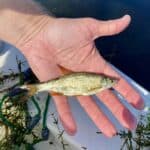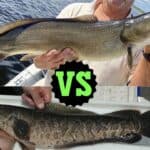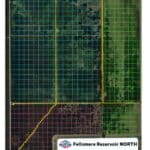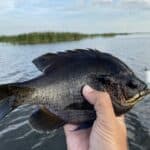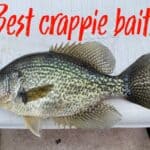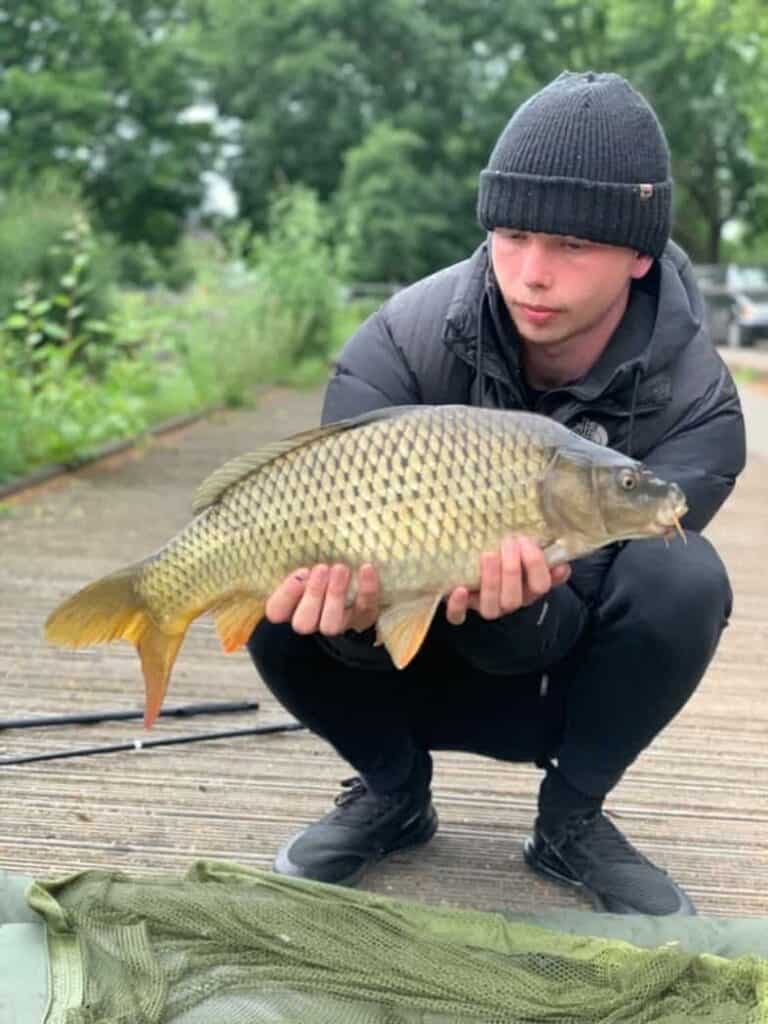
Whether you fish in the USA, the UK or other parts of Europe and Asia, The Grass carp and Common carp are two species of roughfish that you may encounter…but how do you tell the species apart?
This page contains affiliate links. As an Amazon Associate, I earn from qualifying purchases.
Table of Contents
How can you tell the difference between a Common Carp and a Grass Carp?
Common carp are deep-bodied, and the mouth has a pair of barbels on either side. The dorsal fin is elongated, and the fish is yellow or brown. The Grass carp is a slender torpedo-shaped fish with no barbels at the mouth and a short dorsal fin. The Grass carp is olive to silver or grey in color.
How To Identify Common Carp
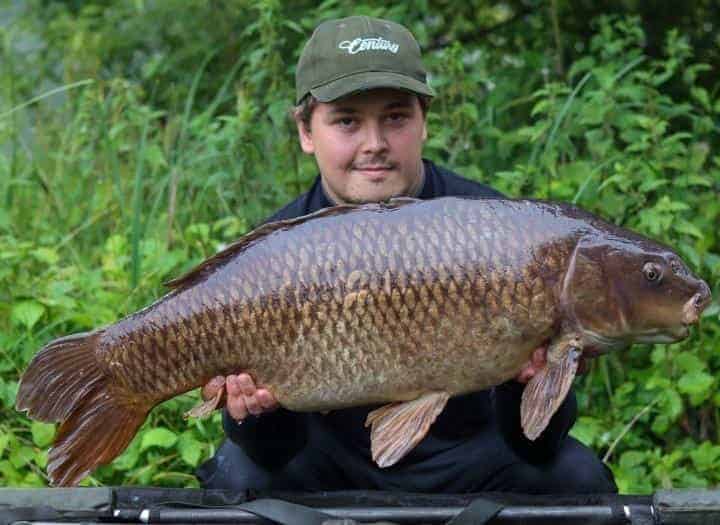
Common carp, sometimes called European carp, are less common than their name implies, and these fish originated in Europe, particularly Eastern Europe and into Germany, but it also occurs in Asia.
The following are the distinguishing features of the Common carp.
- Common carp are a fairly chunky fish, which is often termed deep-bodied.
- The common colors they are found in are yellow, almost golden color, or brown and grey.
- The mouth is angled downward.
- There are a pair of barbels on each side of the mouth.
- The eye is positioned higher than the mouth on the head of the fish.
- The dorsal fin is long and elongated down the top of the body to end in line with the anal fin on the bottom of the fish.
- Common carp can grow up to a length of around 47-inches, and weigh up to 88-pounds.
How To Identify Grass Carp
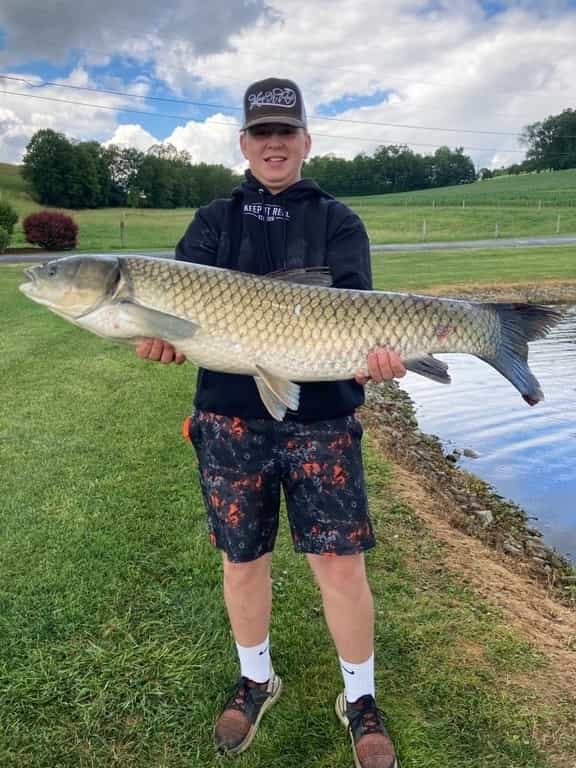
Grass carp are an Asian species that originated in the area of northern Vietnam and the Siberian-China border.
They were introduced to US waters as a means of controlling aquatic weeds since they primarily eat plant material.
Grass carp are wary feeders, which makes them a challenge for anglers to catch. Once they are on the hook, they put up a strong fight, which also makes them an attractive species for anglers who enjoy the challenge of a fighting fish.
The following are the distinguishing features of the Grass carp.
- Grass carp are fairly slender, long, torpedo-shaped fish.
- The common colors of Grass carp are olive to silver and grey in color.
- The mouth is oblique with only a very slight downturn of the mouth.
- The Grass carp has no barbels at all on the mouth.
- The grass carp eye is positioned at the same level as the mouth of the fish.
- The dorsal fin is short and not elongated, with only 8 to 10 soft rays in the fan of the fin.
- Grass carp can grow to a length of 6-feet 6-inches and weigh up to 90-pounds.
Grass Carp vs Common Carp
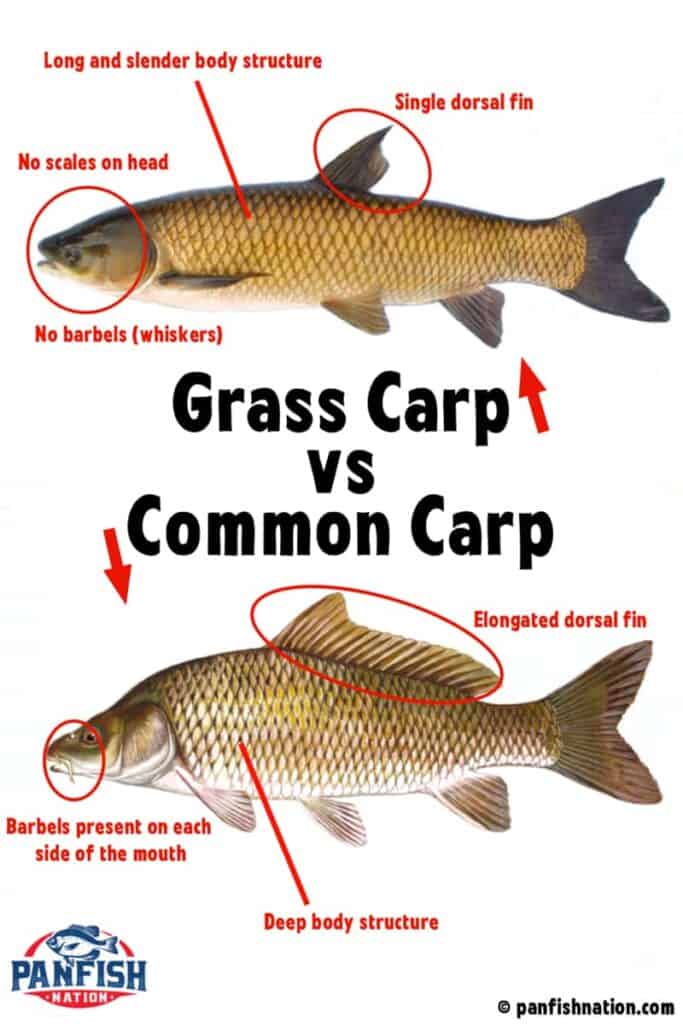
| Feature | Common Carp | Grass Carp |
| Body Shape | Common carp are deep-bodied fish that look chunky. | Grass carp are slender, elongated fish with torpedo-shaped body. |
| Color | Golden yellow, brown, grey | Olive, silver, grey |
| Mouth Shape | Pronounced downward-angled mouth. | Only slightly downward angled mouth. |
| Barbels | One pair of barbels on either side of the mouth. | Barbels are absent. |
| Eye Position | The eye is positioned above the mouth, relatively high up on the head. | The eye is positioned in line with the mouth. |
| Dorsal Fin | The long elongated dorsal fin extends down almost a third of the length of the fish. | A short stubby dorsal fin that is in line with the pelvic fin only. |
| Size | Common carp only get to about 47-inches in length and weigh up to 88-pounds | Grass carp can get to over 6-feet in length and weigh up to 90-pounds. |
Fishing for Carp Species
The rules about fishing for carp vary from state to state, and country to country. Always check with your local fish and wildlife agency to determine regulations.
In some regions where Grass carp have been introduced to control aquatic vegetation, you are only allowed to catch and release these fish. In other regions, These fish have become problematic, and you are not allowed to release them once you have caught them.
Common carp are often seen to be less of a problem because of their prolific breeding and eating but rather because of the way that they eat.
Common carp like to get grubs and mollusks that live in the muddy bottom of the water. As a result, they stir up the mud from the bottom and turn clear water into muddy, turbid water.
This muddy water is often a problem for local fish species that prefer clear, clean water to be able to hunt and breed.
As a result, the Common carp have also become a problem in some waters where populations of local fish species have become threatened as a result of the introduction of common carp. However, the rules around keeping or releasing these fish vary from region to region.
Always make sure that you are familiar with the local rules around these fish so that when you catch one, you can firstly identify it, and secondly, you know what the rules are regarding releasing it.
The bait for carp is much different than what you might expect… In fact, carp are known to eat some really weird stuff…cheese, soap, cornbread, crayons, dough, and much more!
In any case, fishing for carp is very similar to fishing for big catfish. You’ll want to use medium-heavy tackle, and fish on the bottom.
Carp, Invasive or Naturalized?
Carp fishing has become very popular over the past decade in the United States. In Europe, carp fishing is very popular in places like the United Kingdom, Germany and Croatia.
Carp are prized fish in Europe and Asia as an eating fish, but the fish that were introduced to the US adapted to the new environment, which changed the flavor of the fish. In most the United States, carp are not considered good quality table fair.
Local species of fish are much tastier (such as the popular Black Crappie and Walleye), and the introduced carp did not taste like the carp from Asia or Europe, so the fish is no longer considered a food fish in the USA.
In the United States both Grass Carp and Common Carp are considered to be non-native species.
Carp are omnivores and primarily feed on vegetative detritus, aquatic plants, plants, grubs, insects, larvae and plankton.
They have also been known to feed on small fish and this is why you may hook into one even if you are fishing for a predatory fish like largemouth bass or catish.
Carp can put up a surprising fight on the line once they get hooked, which is why some anglers enjoy fighting these fish. They are often targeted by fly fishermen on light tackle to test the skill of the angler.
Carp are also introduced into many residential waterways such as canals and retention ponds which makes them a favorite among neighborhood anglers.
Conclusion
Both the common carp and the grass carp are introduced species to the waters of the US and many other countries. They are popular among anglers for the difficulty in tempting these large fish to bite.
Carp fishing is a growing in the United States, and because we have both the Common Carp and the Grass Carp it’s important anglers understand the differences.
The next time you are looking for a change of pace…consider targeting big carp on light tackle!
These prehistoric fish often grow to enormous sizes and put up a great fight. Good luck!
If you haven’t guessed yet, I love fishing and everything about it!
To learn more about why I started Panfish Nation, visit the About page and follow along on Social Media:


Download a copy of my FREE Lure Color Selection Chart & Knot Guide!
Stay up to date with fishing reports, tackle reviews, industry news, and much more! We respect your privacy, unsubscribe at any time.

